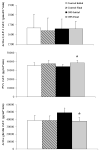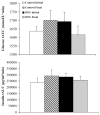Weight loss during oligofructose supplementation is associated with decreased ghrelin and increased peptide YY in overweight and obese adults
- PMID: 19386741
- PMCID: PMC3827013
- DOI: 10.3945/ajcn.2009.27465
Weight loss during oligofructose supplementation is associated with decreased ghrelin and increased peptide YY in overweight and obese adults
Abstract
Background: Rodent studies show that oligofructose promotes weight loss, stimulates satiety hormone secretion, reduces energy intake, and improves lipid profiles.
Objective: Our objective was to examine the effects of oligofructose supplementation on body weight and satiety hormone concentrations in overweight and obese adults.
Design: This study was a randomized, double-blind, placebo-controlled trial. Forty-eight otherwise healthy adults with a body mass index (in kg/m2) > 25 were randomly assigned to receive 21 g oligofructose/d or a placebo (maltodextrin) for 12 wk. Body composition (by dual-energy X-ray absorptiometry); meal tolerance tests, including satiety hormone response; food intake; and subjective appetite ratings were determined.
Results: There was a reduction in body weight of 1.03 +/- 0.43 kg with oligofructose supplementation, whereas the control group experienced an increase in body weight of 0.45 +/- 0.31 kg over 12 wk (P = 0.01). A lower area under the curve (AUC) for ghrelin (P = 0.004) and a higher AUC for peptide YY (PYY) with oligofructose (P = 0.03) coincided with a reduction in self-reported caloric intake (P < or = 0.05). Glucose decreased in the oligofructose group and increased in the control group between initial and final tests (P < or = 0.05). Insulin concentrations mirrored this pattern (P < or = 0.05). Oligofructose supplementation did not affect plasma active glucagon-like peptide 1 secretion. According to a visual analog scale designed to assess side effects, oligofructose was well tolerated.
Conclusions: Independent of other lifestyle changes, oligofructose supplementation has the potential to promote weight loss and improve glucose regulation in overweight adults. Suppressed ghrelin and enhanced PYY may contribute in part to the reduction in energy intake. The trial was registered at clinicaltrials.gov as NCT00522353.
Conflict of interest statement
None of the authors declared a conflict of interest.
Figures






Similar articles
-
The impact of oligofructose on stimulation of gut hormones, appetite regulation and adiposity.Obesity (Silver Spring). 2014 Jun;22(6):1430-8. doi: 10.1002/oby.20754. Epub 2014 Apr 8. Obesity (Silver Spring). 2014. PMID: 24715424 Clinical Trial.
-
Effects of oligofructose on appetite profile, glucagon-like peptide 1 and peptide YY3-36 concentrations and energy intake.Br J Nutr. 2011 Dec;106(11):1757-62. doi: 10.1017/S0007114511002194. Epub 2011 Jun 17. Br J Nutr. 2011. PMID: 21679485 Clinical Trial.
-
Prebiotic supplementation improves appetite control in children with overweight and obesity: a randomized controlled trial.Am J Clin Nutr. 2017 Apr;105(4):790-799. doi: 10.3945/ajcn.116.140947. Epub 2017 Feb 22. Am J Clin Nutr. 2017. PMID: 28228425 Clinical Trial.
-
Resistant starch lowers postprandial glucose and leptin in overweight adults consuming a moderate-to-high-fat diet: a randomized-controlled trial.Nutr J. 2017 Feb 21;16(1):14. doi: 10.1186/s12937-017-0235-8. Nutr J. 2017. PMID: 28222742 Free PMC article. Clinical Trial.
-
Gastrointestinal peptides in eating-related disorders.Physiol Behav. 2021 Sep 1;238:113456. doi: 10.1016/j.physbeh.2021.113456. Epub 2021 May 11. Physiol Behav. 2021. PMID: 33989649 Free PMC article. Review.
Cited by
-
Development of shoulder osteoarthritis and bone lesions in female and male rats subjected to a high fat/sucrose diet.Sci Rep. 2024 Oct 28;14(1):25871. doi: 10.1038/s41598-024-76703-4. Sci Rep. 2024. PMID: 39468197 Free PMC article.
-
Role of Gut Microbial Metabolites in Cardiovascular Diseases-Current Insights and the Road Ahead.Int J Mol Sci. 2024 Sep 23;25(18):10208. doi: 10.3390/ijms251810208. Int J Mol Sci. 2024. PMID: 39337693 Free PMC article. Review.
-
The role of probiotics on the roadmap to a healthy microbiota: a symposium report.Gut Microbiome (Camb). 2020 Aug 26;1:e2. doi: 10.1017/gmb.2020.2. eCollection 2020. Gut Microbiome (Camb). 2020. PMID: 39296722 Free PMC article. Review.
-
Gut microbes, diet, and genetics as drivers of metabolic liver disease: a narrative review outlining implications for precision medicine.J Nutr Biochem. 2024 Nov;133:109704. doi: 10.1016/j.jnutbio.2024.109704. Epub 2024 Jul 17. J Nutr Biochem. 2024. PMID: 39029595 Review.
-
Role of the intestinal microbiota in contributing to weight disorders and associated comorbidities.Clin Microbiol Rev. 2024 Sep 12;37(3):e0004523. doi: 10.1128/cmr.00045-23. Epub 2024 Jun 28. Clin Microbiol Rev. 2024. PMID: 38940505 Review.
References
-
- Chaudhri OB, Salem V, Murphy KG, Bloom SR. Gastrointestinal satiety signals. Annu Rev Physiol. 2008;70:239–55. - PubMed
-
- Cani PD, Joly E, Horsmans Y, Delzenne NM. Oligofructose promotes satiety in healthy humans: a pilot study. Eur J Clin Nutr. 2006;60:567–72. - PubMed
-
- Drucker DJ. The biology of incretin hormones. Cell Metab. 2006;3:153–65. - PubMed
-
- Grudell AB, Camilleri M. The role of peptide YY in integrative gut physiology and potential role in obesity. Curr Opin Endocrinol Diabetes Obes. 2007;14:52–7. - PubMed
-
- Batterham RL, Cowley MA, Small CJ, et al. Gut hormone PYY (3–36) physiologically inhibits food intake. Nature. 2002;418:650–4. - PubMed
Publication types
MeSH terms
Substances
Associated data
Grants and funding
LinkOut - more resources
Full Text Sources
Other Literature Sources
Medical

